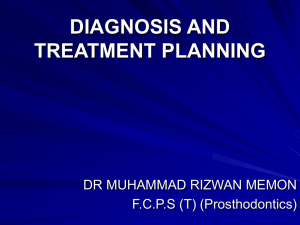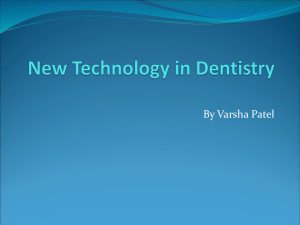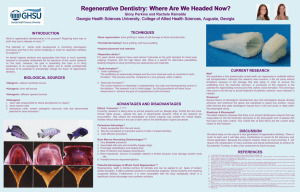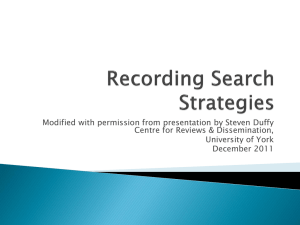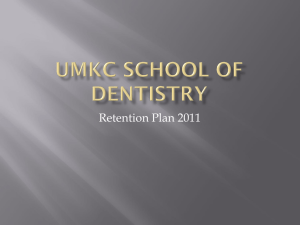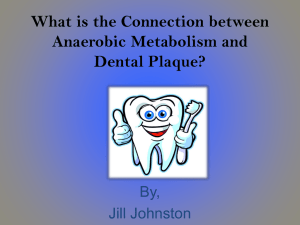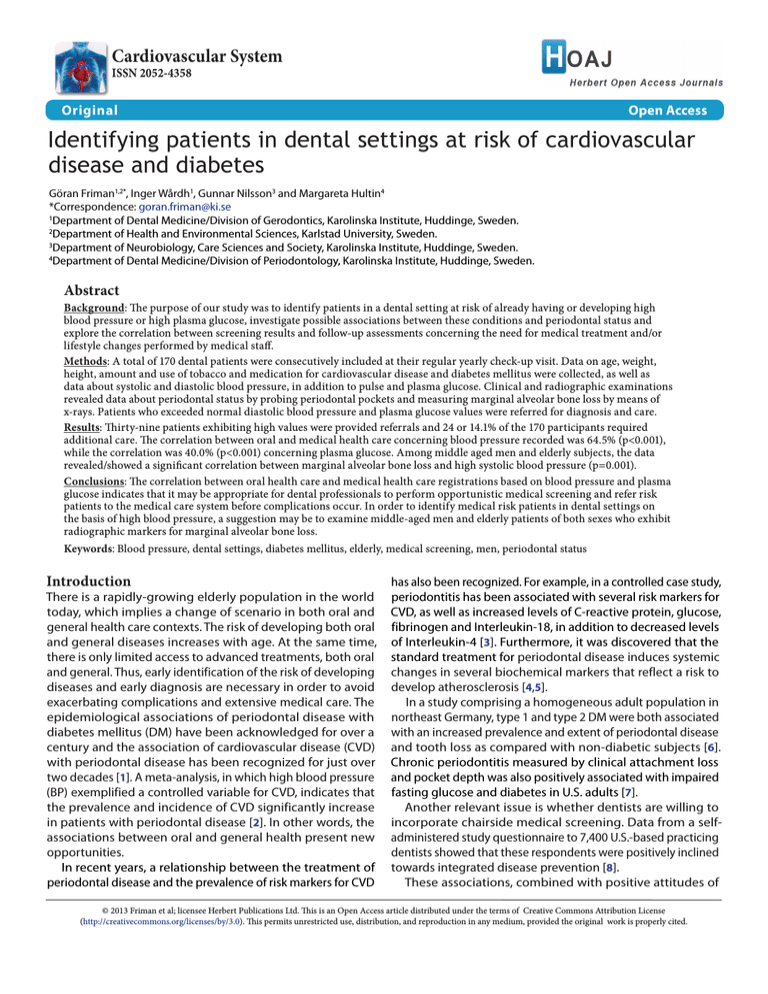
Cardiovascular System
ISSN 2052-4358
Original
Open Access
Identifying patients in dental settings at risk of cardiovascular
disease and diabetes
Göran Friman1,2*, Inger Wårdh1, Gunnar Nilsson3 and Margareta Hultin4
*Correspondence: goran.friman@ki.se
1
Department of Dental Medicine/Division of Gerodontics, Karolinska Institute, Huddinge, Sweden.
2
Department of Health and Environmental Sciences, Karlstad University, Sweden.
3
Department of Neurobiology, Care Sciences and Society, Karolinska Institute, Huddinge, Sweden.
4
Department of Dental Medicine/Division of Periodontology, Karolinska Institute, Huddinge, Sweden.
Abstract
Background: The purpose of our study was to identify patients in a dental setting at risk of already having or developing high
blood pressure or high plasma glucose, investigate possible associations between these conditions and periodontal status and
explore the correlation between screening results and follow-up assessments concerning the need for medical treatment and/or
lifestyle changes performed by medical staff.
Methods: A total of 170 dental patients were consecutively included at their regular yearly check-up visit. Data on age, weight,
height, amount and use of tobacco and medication for cardiovascular disease and diabetes mellitus were collected, as well as
data about systolic and diastolic blood pressure, in addition to pulse and plasma glucose. Clinical and radiographic examinations
revealed data about periodontal status by probing periodontal pockets and measuring marginal alveolar bone loss by means of
x-rays. Patients who exceeded normal diastolic blood pressure and plasma glucose values were referred for diagnosis and care.
Results: Thirty-nine patients exhibiting high values were provided referrals and 24 or 14.1% of the 170 participants required
additional care. The correlation between oral and medical health care concerning blood pressure recorded was 64.5% (p<0.001),
while the correlation was 40.0% (p<0.001) concerning plasma glucose. Among middle aged men and elderly subjects, the data
revealed/showed a significant correlation between marginal alveolar bone loss and high systolic blood pressure (p=0.001).
Conclusions: The correlation between oral health care and medical health care registrations based on blood pressure and plasma
glucose indicates that it may be appropriate for dental professionals to perform opportunistic medical screening and refer risk
patients to the medical care system before complications occur. In order to identify medical risk patients in dental settings on
the basis of high blood pressure, a suggestion may be to examine middle-aged men and elderly patients of both sexes who exhibit
radiographic markers for marginal alveolar bone loss.
Keywords: Blood pressure, dental settings, diabetes mellitus, elderly, medical screening, men, periodontal status
Introduction
There is a rapidly-growing elderly population in the world
today, which implies a change of scenario in both oral and
general health care contexts. The risk of developing both oral
and general diseases increases with age. At the same time,
there is only limited access to advanced treatments, both oral
and general. Thus, early identification of the risk of developing
diseases and early diagnosis are necessary in order to avoid
exacerbating complications and extensive medical care. The
epidemiological associations of periodontal disease with
diabetes mellitus (DM) have been acknowledged for over a
century and the association of cardiovascular disease (CVD)
with periodontal disease has been recognized for just over
two decades [1]. A meta-analysis, in which high blood pressure
(BP) exemplified a controlled variable for CVD, indicates that
the prevalence and incidence of CVD significantly increase
in patients with periodontal disease [2]. In other words, the
associations between oral and general health present new
opportunities.
In recent years, a relationship between the treatment of
periodontal disease and the prevalence of risk markers for CVD
has also been recognized. For example, in a controlled case study,
periodontitis has been associated with several risk markers for
CVD, as well as increased levels of C-reactive protein, glucose,
fibrinogen and Interleukin-18, in addition to decreased levels
of Interleukin-4 [3]. Furthermore, it was discovered that the
standard treatment for periodontal disease induces systemic
changes in several biochemical markers that reflect a risk to
develop atherosclerosis [4,5].
In a study comprising a homogeneous adult population in
northeast Germany, type 1 and type 2 DM were both associated
with an increased prevalence and extent of periodontal disease
and tooth loss as compared with non-diabetic subjects [6].
Chronic periodontitis measured by clinical attachment loss
and pocket depth was also positively associated with impaired
fasting glucose and diabetes in U.S. adults [7].
Another relevant issue is whether dentists are willing to
incorporate chairside medical screening. Data from a selfadministered study questionnaire to 7,400 U.S.-based practicing
dentists showed that these respondents were positively inclined
towards integrated disease prevention [8].
These associations, combined with positive attitudes of
© 2013 Friman et al; licensee Herbert Publications Ltd. This is an Open Access article distributed under the terms of Creative Commons Attribution License
(http://creativecommons.org/licenses/by/3.0). This permits unrestricted use, distribution, and reproduction in any medium, provided the original work is properly cited.
Friman et al. Cardiovascular System 2013,
http://www.hoajonline.com/journals/pdf/2052-4358-1-5.pdf
doi: 10.7243/2052-4358-1-5
agreement with the terms of the Helsinki Declaration.
Invitation to study
Yearly check-up and screening
data collection
Information to patient
data results
Referral to medical doctor if needed
Visit to medical doctor
Diagnosis and relevant therapy or
health promotion advice
Receiving doctor’s statement
Figure 1. Flow chart for medical screening in dental
settings.
Setting
This study was performed in an everyday dental setting in
a small town in mid-Sweden. At the time of the study, the
clinic was responsible for treating about 1,450 adult patients
with a mean age of approximately 57 years ranging from
20 to approximately 100 in age. All patients were enrolled
in an individualized prophylactic care program and had
appointments with the dental hygienist or prophylactic dental
nurse on an individual basis. In addition to the prophylactic
program, an annual full-mouth dental examination was
generally performed on each patient by a dentist. For a flow
chart of the medical screening, see (Figure 1).
Subject selection
Two hundred seven consecutive regular patients ≥ 40 years
of age who had been recalled to their regular yearly checkup visits between March and October 2004 were invited
to participate in the study. One hundred seventy patients
agreed to participate. Upon receiving both verbal and written
information about the study, all subjects included gave their
informed consent for the study to be conducted.
Study subjects were divided into two groups:
1. Middle-aged : Patients ≥ 40 - ≤ 64 years of age during
the year of data collection.
2. Elderly : Patients ≥ 65 years of age during the year of
data collection.
Data collection
Data were collected through a self-administered written health
declaration made before the dental appointment: age, weight,
height, type and amount of tobacco use and medication to
treat CVD and DM. Body mass index (BMI) was calculated and
defined as an individual’s body weight divided by the square
of his or her height. Overweight was defined as a BMI value
above 30.0 for men and above 28.6 for women.
Clinical examination
After a five-minute rest in the dentist’s examination chair in
dentists make it desirable to implement medical screening the examining room, using digital BP registration [11], data
for high BP [9] and DM [10] in dental settings. The purpose of about both systolic and diastolic BP and pulse were collected.
our study was to identify patients in an ordinary real-world The BP and pulse rate were measured by using a wrist device,
dental setting at risk of already having or developing high an automatic sphygmomanometer NAIS DIAGNOSTEC EW
blood pressure or high plasma glucose, investigate possible 3002 (Matsushita Electric Works, Germany).
associations between these conditions and periodontal
Plasma glucose was measured by means of a digital capillary
status and explore the correlation between screening results blood sample, 3-3.5 μL using a medical device, a glucometer
and follow-up assessments concerning the need for medical called Roche Accu-Chek Compact (Roche Diagnostics GmbH,
treatment and/or lifestyle changes performed by medical staff. Roche Diabetes Care, D-68298 Mannheim, Germany). The
device was independently and objectively evaluated [12].
Methods
Data collection for plasma glucose was not predominantly
The study was approved by the local Ethical Committee performed with fasting patients, which explains why the
in Uppsala, Sweden (file 2005:358) and was conducted in risk values determined rather than the diagnosis, were set
2
Friman et al. Cardiovascular System 2013,
http://www.hoajonline.com/journals/pdf/2052-4358-1-5.pdf
by an experienced diabetes physician, Gunilla Hede of the
Diabetes Centre, Karlstad Hospital, Sweden, with respect to
the time lapsed since last consumed meal. For patients who
had eaten during the past two hours, the value was set at 9.5
mmol/litre plasma and for those who not had eaten during
the past two hours, the value was established at 8.0 mmol/
litre plasma. For those fasting for the past eight hours, the
cut-off value was set at 7.0 mmol/litre plasma [13].
The cut-off values for diastolic BP was set at 90 mm Hg
or more, except for diabetics in which case the value was
set at 85 mm Hg or more, generally 140 mm Hg or more for
systolic BP. Patients who exceeded normal plasma glucose
and diastolic BP values were referred to a medical doctor to
have their values checked, possibly determine a diagnosis
and initiate relevant therapy, or alternatively, receive health
promotion advice [1].
All patients underwent clinical and radiographic examination performed by one of the clinic’s two experienced
and calibrated dentists who followed a detailed written
protocol for data collection. These dentists have enjoyed a
lengthy professional relationship, both in educational and
clinical contexts, and daily discuss how to best measure and
interpret clinical findings. Other categories of staff had been
undergoing training specific to the medical screening project.
The number of teeth was counted. Clinical periodontal status
was assessed by recording bleeding on probing (BOP) and
by probing the pocket depth on five predetermined teeth in
each patient, tooth numbers 16, 21, 24, 41, 44 [14] using a
periodontal probe, LM 23-520B Si with a 0.5 mm ball diameter
tip (LM-Instruments Oy, Finland).
Pocket depth was measured on six surfaces of each selected
tooth (distobuccal, midbuccal, mesiobuccal, mesiolingual,
midlingual, distolingual) and expressed in mm as the distance
between the gingival margin and the base of the periodontal
pocket. Recordings of pocket depth and BOP were made
on four surfaces (distal, buccal, mesial and lingual) on each
measured tooth, choosing the deepest site on the measured
approximal surface. Only a pocket depth of ≥ 4 mm was
recorded.
Radiographic examination
doi: 10.7243/2052-4358-1-5
Table 1. Quartiles of clinical and radiographic periodontal
status.
Periodontal status
Lower quartile Between lower and
(q1)
upper quartiles (q2)
Upper quartile
(q3)
Number of pockets with
depth ≥ 4 mm
0
>0-<3
>3
Mean depth of pockets
≥ 4 mm
0 mm
> 0 - < 4.5 mm
> 4.5 mm
Total mm of pocket depth
≥ 4 mm
0 mm
> 0 - < 15 mm
> 15 mm
Marginal alveolar bone loss
< 2 mm
> 2 - < 3.4 mm
> 3.4 mm
and rounded off to the nearest 0.1 mm (0.05 rounded up).
Marginal alveolar bone loss represents the mean distance of
each patient. Radiographic readings were made in a randomly
selected order twice by two independent readers, authors
GF and MH. If the CEJ on an approximal surface could not
be detected, the CEJ on the opposite surface of the same
tooth or the neighbouring tooth was used as reference.
Missing data or which the CEJ or marginal bone crest was
undetectable, were specified as percentages of the total
number of measured surfaces.
The agreement among examiners on radiographic readings
was 90% and an analysis of the correspondence of the
radiographic readings between the two examiners showed
that the principal investigator (GF) measured the marginal
bone loss to be a mean 0.1 mm less than the co-author and
specialist in periodontology (MH).
Quartiles of clinical and radiographic periodontal status
To evaluate variations of BP and plasma glucose in patients
with varying clinical and radiographic periodontal status,
partitions into quartiles were set on marginal alveolar bone
loss, as well as the number and mean depth of periodontal
pockets bleeding with a total registered pocket depth of ≥
4 mm. (Table 1) shows the partition into quartiles.
Statistical analysis
Statistical analyses were performed using the SPSS statistical
software (Release 18.0.0 SPSS Inc., Chicago, IL). Potential
correlations between periodontal status and systolic/diastolic
BP were analyzed using Student’s t-test, Spearman’s rank
correlation and Chi-Square Tests with a p-value ≤ 0.05 as
significance level.
A radiographic examination [15] of the periodontal status
was undertaken on dentate patients and comprised of two or
four bitewing x-rays using a standardized long-cone parallel
technique, a routine examination as part of the yearly check-up Results
visit. No bitewing x-rays were taken on patients with canine Background data
to canine small dentitions.
Of the 207 consecutively invited patients, 170 were recruited at
The marginal alveolar bone loss on bitewing radiographs their recalls for regular yearly check-up visits. The dropout rate
was measured on each patient using a digital slide calliper was 17.9%, with the main explanations for not participating
from the cemento-enamel-junction (CEJ) to the crest of “no special reason” or “have regular medical care contact”.
the alveolar bone on the approximal surfaces of canines, Other common reasons were “long distance for any sampling”
premolars and molars. A Mattson binocular with two-fold and “do not want to know about an undiagnosed illness”.
magnification was used to measure the mm distance from Rare frequent reasons included “don’t want” and “have given
the CEJ to the alveolar bone crest. The distance was recorded lab-samples elsewhere”.
3
Friman et al. Cardiovascular System 2013,
http://www.hoajonline.com/journals/pdf/2052-4358-1-5.pdf
doi: 10.7243/2052-4358-1-5
Table 2. General and related medical background data.
Total
N=170 (100 %)
Middle-aged
n=90 (52.9%)
Elderly
n=80 (47.1%)
Total
Men/ Women
Total
Men/ Women
Total
170
76/94
90
42/48
80
34/46
% in group
-
44.7/55.3
-
46.7/53.3
-
42.5/57.5
Mean BMI
26.3
26.6/26.1
27.0
27.8/26.3
25.6
25.1/25.9
31
13/18
21
11/10
10
2/8
18.2
17.1/19.1
23.3
26.2/20.8
12.5
5.9/17.4
Total
Overweight BMI
% in group
Smokers
% in group
Smoked 6 or more cigarettes/day
% in group
Medication for CVD. anti- hypertension medication
% within group
Men/ Women
23
10/13
19
8/11
4
2/2
13.5
13.2/13.8
21.1
19.0/22.9
5.0
5.9/4.3
17
6/11
16
6/10
1
0/1
10.0
7.9/11.7
17.8
14.3/20.8
1.3
0/2.2
59
25/34
18
8/10
41
17/24
50.0/52.2
34.7
32.9/36.2
20.0
19.0/20.8
51.3
Medication for diabetes mellitus
12
9/3
5
4/1
7
5/2
% in group
7.1
11.8/3.2
5.6
9.5/2.1
8.8
14.7/4.3
Mean pulse rate
69.3
69.1/69.4
70.2
70.9/69.6
68.3
67.0/69.2
One individual medicated for low BP
The mean age was 63.95 years (SD 12.4) ranging from 40 to
88, with more women (94) than men (76) participating. Two
patients (1.2%) were edentulous and 31 patients (18.2%) were
overweight according to their BMI values.
of ≥ 4 mm, mean depth ≥ 4 mm and total mm pocket depth
≥ 4 mm were significant (p<0.001). These clinical periodontal
status parameters are presented below as data of the number
of pockets with depth of ≥ 4 mm.
When all subjects had been analyzed, we found no
Plasma glucose and blood pressure
significant correlations between the number of teeth or the
Of the 170 participating patients, 39 were referred to a medical clinical periodontal status and diastolic BP. Three out of four
doctor due to high diastolic values and/or high plasma subjects with diastolic BP above the cut-off level (90 mm Hg;
glucose levels at their screenings. Ten of these 39 patients 85 mm Hg for patients with diagnosed DM) had pockets with
exhibited plasma glucose values beyond the cut-off level, a depth of ≥ 4 mm, and 14 of the 31 subjects (45.2%) with
fasting glucose > 7.0 millimoles per litre (mmol/l) or values diastolic BP above the cut-off level had ≥ 3 pockets with a
in excess of levels adjusted to elapsed time since their last depth of ≥ 4 mm. Please see (Table 4) for correlations between
meals. Four of these ten required further care according to blood pressure, plasma glucose (PG) and periodontal status.
the medical physician conducting their examinations. The
There were significant correlations between the number
correlation between oral health care and medical care in of teeth and systolic BP (p=0.015) as well as medication
recording plasma glucose was 40.0% (p<0.001).
to alleviate CVD (p=0.005 and non-parametric correlation
Thirty-one of the 39 who were referred exhibited diastolic p<0.001), but no correlation was found between the number of
BP beyond the cut-off level at the screenings. Twenty of these teeth and clinical periodontal status. The correlation between
31 patients who exceeded normal diastolic blood pressure plasma glucose and clinical periodontal status displayed
required further care according to the examining medical no significance, but 57.1% of those subjects who exhibited
physician. The correlation between oral health care and plasma glucose above the cut-off level and who were not on
medical care in recording blood pressure was 64.5% (p<0.001). medication for DM had ≥ 3 pockets with a depth of ≥ 4 mm.
Three of these 20 also required further care caused by high
plasma glucose, which demonstrates the close relation Radiographic periodontal status
between high BP and high plasma glucose. We found systolic In 16 cases (9.4%), it was not at all possible to measure the
BP significant correlated to plasma glucose (p=0.005).
marginal alveolar bone loss on x-ray owing to their being
Consequently, 24 (61.5%) out of the 39 referred patients edentulous, having small dentitions or a total lack of reference
required additional care (p<0.001). For further general and points on x-rays: among middle-aged subjects 3.3% and among
medical-related background data and periodontal status, elderly subjects 16.3% fell into this category. The mean for
please see (Tables 2 and 3). Eighty-eight of the 170 patients missing data was 20.3% of the 154 cases under study; among
had systolic BP beyond the cut-off level.
middle-aged subjects the mean was 10.8% and among elderly
subjects, the mean for missing data was 32.8%.
Clinical periodontal status and number of teeth
There was no significant correlation between plasma
The correlations between the number of pockets with depth glucose and radiographic periodontal status, but all subjects
4
Friman et al. Cardiovascular System 2013,
http://www.hoajonline.com/journals/pdf/2052-4358-1-5.pdf
doi: 10.7243/2052-4358-1-5
Table 3. Periodontal status.
Radiographic
periodontal status
Clinical periodontal status
Number of pockets with
depth ≥ 4 mm
Men
< 65 years
Women
Total
Men
> 65 years
Women
Total
Mean pocket depth
≥ 4 mm
Total mm of registered
pocket depth ≥ 4 mm
Total dentated
(Total x-rayed)
Marginal alveolar
bone loss
Quartiles
q1
q2
q3
q1
q2
q3
q1
q2
q3
q1
q2
q3
-
Count
9
15
18
8
19
15
8
21
13
17
21
3
42 (41)
21.4
37.5
42.9
19.0
45.2
35.7
19.0
50.0
31.0
41.5
51.2
7.3
100.0
16
13
19
16
19
13
16
18
14
13
26
7
48 (46)
33.3
27.1
39.6
33.3
39.6
27.1
33.3
37.5
29.2
28.3
56.5
15.2
100.0
25
28
37
24
38
28
24
39
27
30
47
10
90 (87)
27.8
31.1
41.1
26.7
42.2
31.1
26.7
43.3
30.0
34.5
54.0
11.5
100.0
14
10
9
14
11
8
14
13
6
3
10
16
33 (29)
42.4
30.3
27.3
42.4
33.3
24.2
42.4
39.4
18.2
10.3
34.5
55.2
100.0
20
16
9
20
17
8
20
16
9
8
17
13
45 (38)
44.4
35.6
20.0
44.4
37.8
17.8
44.4
35.6
20.0
21.1
44.7
34.2
100.0
34
26
18
34
28
16
34
29
15
11
27
29
78 (67)
43.6
33.3
23.1
43.6
35.9
20.5
43.6
37.2
19.2
16.4
40.3
43.3
100.0
% in sex
Count
% in sex
Count
% in age group
Count
% in sex
Count
% in sex
Count
% in age group
Table 4. Correlation between blood pressure, plasma glucose and periodontal status.
Quartiles
Number of teeth
< 20 teeth
% in BP & PG group
> 20 teeth
% in BP & PG group
Number of pockets ≥ 4mm with PD of ≥ 4mm
q1
% in BP & PG group
q2
% in BP & PG group
q3
% in BP & PG group
Mean pocket depth ≥ 4mm
q1
% in BP & PG group
q2
% in BP & PG group
q3
% in BP & PG group
Total mm of registered PD of ≥ 4 mm
q1
% in BP & PG group
q2
% in BP & PG group
q3
% in BP & PG group
Marginal alveolar bone loss
q1
% in BP & PG group
q2
% in BP & PG group
q3
% in BP & PG group
Diastolic BP
< 90 (< 85)
Diastolic BP
> 90 (85)
Systolic BP
< 140
Systolic BP
> 140
PG below cut-off
level (non- DM
medication)
PG beyond cut-off
level (non- DM
medication)
48
9
20
37
54 (55)
3 (2)
34.5
29.0
24.4
42.0
33.8 (33.7)
30.0 (28.6)
91
22
62
51
106 (108)
7 (5)
65.5
71
75.6
58.0
66.3 (66.3)
70.0 (71.4)
51
8
27
32
54 (57)
5 (2)
37.2
25.8
32.9
37.2
34.2 (35.4)
50.0 (28.6)
45
9
22
32
53 (53)
1 (1)
32.8
29.0
26.8
37.2
33.5 (32.9)
10.0 (14.3)
41
14
33
22
51 (51)
4 (4)
29.9
45.2
40.2
25.6
32.3 (31.7)
40.0 (57.1)
50
8
27
31
54 (56)
4 (2)
36.5
25.8
32.9
36.0
34.2 (34.8)
40.0 (28.6)
55
11
31
35
63 (64)
3 (2)
40.1
35.5
37.8
40.7
39.9 (39.8)
30.0 (28.6)
32
12
24
20
41 (41)
3 (3)
23.4
38.7
29.3
23.3
25.9 (25.5)
30.0 (42.9)
50
8
27
31
54 (56)
4 (2)
36.5
25.8
32.9
36.0
34.2 (34.8)
40.0 (28.6)
54
14
29
39
65 (66)
3 (2)
39.4
45.2
35.4
45.3
41.1 (41.0)
30.0 (28.6)
33
9
26
16
39 (39)
3 (3)
24.1
29.0
31.7
18.6
24.7 (24.2)
30.0 (42.9)
35
6
25
16
41 (41)
0 (0)
27.8
21.4
31.6
21.3
28.5 (27.9)
0 (0)
62
12
42
32
69 (71)
5 (3)
49.2
42.9
53.2
42.7
47.9 (48.3)
50.0 (42.9)
29
10
12
27
34 (35)
5 (4)
23.0
35.7
15.2
36.0
23.6 (23.8)
50.0 (57.1)
who displayed plasma glucose above the cut-off level
exhibited marginal alveolar bone loss ≥ 2 mm, and 57.1%
of the members of this group who were not on medications
for DM had ≥ 3.4 mm.
One hundred thirteen of the 154 dental patients (73.4%)
had radiographic marginal alveolar bone loss of ≥ 2 mm
5
Friman et al. Cardiovascular System 2013,
http://www.hoajonline.com/journals/pdf/2052-4358-1-5.pdf
a
doi: 10.7243/2052-4358-1-5
Systolic blood pressure
Men
Women
Men
Women
Mean distance from ECJ to marginal alveolar bone crest
b
Systolic blood pressure
< 65years old
> 65years old
< 65years old
> 65years old
and a significant non-parametric correlation (p=0.001)
between systolic BP and marginal alveolar bone loss.
Twenty-seven patients out of a group of 39 (69.2%) with
a bone loss of ≥ 3.4 mm showed systolic BP > 140 mm Hg.
The correlation was stronger for men (p=0.001) than for
women (p=0.038) and there was also a significant nonparametric correlation (p=0.008 and p=0.049, respectively)
(Figure 2a). Furthermore, significant correlations for middleaged (p=0.039) and elderly (p=0.029) subjects were also
discovered (Figure 2b). After controlling for age and sex,
significant correlations between systolic BP and marginal
alveolar bone loss remained among middle-aged men
(p=0.036), while no such correlations were found among
women.
Among elderly women, there was a significant correlation
between marginal alveolar bone loss and clinical periodontal
status (p=0.014), while a bone loss of ≥ 2 mm was less
frequent among non-smokers than among smokers.
Age
An analysis of all patients showed significant correlations
between age and medication for CVD (p<0.001), diastolic
BP (p=0.009), systolic BP (p<0.001), marginal alveolar bone
loss (p<0.001), missing radiographic data (p<0.001) and
clinical periodontal status (p=0.002). There were significant
correlations between age and clinical periodontal status
among non-smokers (p=0.016) and men (p=0.007), whereas
no such correlations were discovered among smokers and
women.
Discussion
Main findings
Mean distance from ECJ to marginal alveolar bone crest
Figure 2. (a) Correlation between systolic blood pressure and
marginal alveolar bone loss in different sexes. (b) Correlation
between systolic blood pressure and marginal alveolar bone
loss in different age groups.
according to the distribution in (Table 3). The mean bone loss
of middle-aged subjects was 2.4 mm (SD 0.9) and in elderly
subjects 3.2 mm (SD 1.2).
In analyzing all patients, no significant correlations were
discovered between marginal alveolar bone loss and diastolic
BP. Four of five subjects with diastolic BP above the cut-off
value showed marginal alveolar bone loss of ≥ 2 mm. Of these
113 with ≥ 2 mm, 22 (19.5%) had screened diastolic BP above
the cut-off value, as compared with six patients (14.6%) of 41
with a bone loss of < 2 mm. There was no correlation between
marginal alveolar bone loss (p=0.07) and taking medication
to alleviate CVD.
However, there was both a significant correlation (p<0.001)
We often found undiagnosed high BP and high plasma
glucose values in our 170 subjects. Thirty-nine patients
with high values were referred, with 24 of them requiring
further care (14.1% of all participants).
No significant correlations between plasma glucose and
periodontal status were found. Among elderly subjects, there
was a significant correlation between marginal alveolar
bone loss and high systolic BP.
High BP, a global problem, was noted in 26.4% of the adult
population in 2000 [16], with ischaemic heart disease and
cerebrovascular disease being the leading causes of death
[17]. In this study, we found that registered BP was correlated
to radiographic marginal alveolar bone loss. Male subjects
40-65 years of age evidenced the strongest such correlation,
as did subjects of both genders aged 65 and over.
Incidental findings
Periodontitis in the elderly is not easily confirmed as affected
teeth may already have been extracted, because of a
perceived need for removal or the previous more technical
approach towards dentistry [18]. In this study, we noticed
incidentally that radiographic marginal alveolar bone loss
6
Friman et al. Cardiovascular System 2013,
http://www.hoajonline.com/journals/pdf/2052-4358-1-5.pdf
was present more often than clinical periodontal status, such
as BOP linked to pocket depth of ≥ 4 mm, probably thanks to
the individualized prophylactic care programs used in the
clinic concerned. A pocket depth of ≥ 4 mm may be a sign
of active periodontal disease, while radiographic bone loss
is a clear sign of previous periodontal disease.
In the present study, we also incidentally observed that the
number of surfaces on which it was impossible to measure
marginal alveolar bone loss on x-rays was larger among the
oldest patient group. Elderly tend to have a lot of dental
restorations [19] that complicate the measurement on bitewing
x-rays owing to obscured CEJ.
Contemporary Swedish elderly tend to increasingly keep
their natural teeth [20]. The importance of medical screening
for oral health was highlighted in a study in which the authors
[21] concluded that the metabolic syndrome and presence
of markers for inflammation, in addition to traditional risk
factors for tooth loss, represented threats to maintaining
natural teeth in elderly populations. Relevant current data also
support the existence of a relationship between metabolic
disturbances and periodontitis [22].
doi: 10.7243/2052-4358-1-5
tend to complicate medical screening in dental settings, but
the benefits of medical screening linked to the dental health
system, with its annual recall program, may compensate for
these disadvantages.
Implications of this study
Our findings indicate the possibility of identifying risk patients
among men and elderly by examining radiographic marginal
alveolar bone loss with the help of routine x-rays and by
performing medical screenings by measuring BP. However,
this requires the establishment of good routines for both the
screening procedures and x-ray activities in dental settings.
Another issue is whether dental professionals should be
involved in the follow-up treatment of hypertension, or
alternatively, merely collaborate closely with primary care
services in identifying patients at risk.
The absence of a significant correlation between plasma
glucose and periodontal status in this study may be attributable
to the limited population sample screened or the extended
targeted periodontal prophylaxis received by patients with
diabetes.
Syrjänen [27] discovered that severe chronic dental
Strengths and limitations
infection in young and middle-aged men seems to be strongly
The strength of this investigation is that it was conducted associated with stroke (cerebral infarction), a finding that
at an ordinary public general dental practice by standard stresses the importance of giving men who evidence markers
oral health professionals whose mission was to identify of periodontal disease extended periodontal prophylaxis.
patients at risk of CVD and DM. Today, several wrist devices According to our study findings, this also seems relevant for
have been validated using the British Hypertension Society elderly patients in the same situation.
protocol; however, validated upper arm devices are still
In the absence of a definitive causality, our level of
preferred over wrist devices [23] and should, therefore, knowledge does not yet enable us to call periodontal status
be recommended for screening activities and control a predictive factor for cardiovascular disease or diabetes
measurements. A digital automatic sphygmomanometer mellitus. A statistical limitation also occurs when many
generates values algorithmically based on a single registration. statistical associations tested are omitted. In such instances,
Physiologically, the mean ambulatory monitored BP value error rates may soar dramatically, thereby increasing the risk
is more realistic and has better prognostic value in making of reaching erroneous conclusions. However, the data of our
diagnostic assessments [24], but is less suitable in a screening study might be used to propose a description of cardiovascular
situation. The results also show that although an ordinary parameters and plasma glucose concentrations in groups with
glucometer made for monitoring concentrations of blood affected periodontal status. Our findings suggest a need for
glucose at home was used, a correlation with medical health additional studies with larger population samples.
care of 40.0% was achieved. A limitation of our study is that
Among Swedes aged 50 and above, 81.6% of this population
it was performed in one dental setting alone; other similar reported having seen a dentist within the preceding year in
clinical research needs to be performed before the results 2007 [28]. The continuity of providing ongoing dental services
may be considered transferable to all dental environments. presents an opportunity to identify both oral and general
Another limitation is that we made the assumption that risk factors and points out the benefit of medical screening
patients would feel calm enough to achieve a relevant digital in dental settings which is why such screening activity has
BP registration after a five-minute break. This was not the recently been introduced to dentistry and is the subject of
case, as 88 of 170 patients (51.8%) patients showed systolic research because of its positive results [29-33,8,9,34-37].
BP above the cut-off value of 140 mm Hg. These results
were probably attributable to “white coat hypertension”. Conclusions
Studies have shown that patients with high BP readings at In our study, the correlation between oral health care and
a first appointment with a new physician show a mean fall medical health care registrations based on blood pressure
of 15 ⁄7 mm Hg in systolic BP and diastolic BP by their third and plasma glucose indicates that it may be appropriate
appointment. Some patients do not reach stable BP values for dental professionals to perform opportunistic medical
until their sixth appointment [25,26]. Dental fear and phobia screening and refer risk patients to the medical care system
7
Friman et al. Cardiovascular System 2013,
http://www.hoajonline.com/journals/pdf/2052-4358-1-5.pdf
before complications occur. In order to identify medical risk
patients in dental settings on the basis of high blood pressure,
a suggestion may be to examine middle-aged men and elderly
patients of both sexes who exhibit radiographic markers for
marginal alveolar bone loss.
Abbreviations
DM: Diabetes mellitus
CVD: Cardiovascular disease
BP: Blood pressure
BMI: Body mass index
BOP: Bleeding on probing
CEJ: Cemento-enamel-junction
Competing interests
The authors declare that they have no competing interests.
Authors’ contributions
GF was principal investigator responsible for planning,
design and analysis and wrote the manuscript. IW and
GN were involved in planning, design and analysis and
drafted the revised manuscript. MH was involved in
planning and design and revised the manuscript. All
authors have read and approved the final manuscript.
Acknowledgement and funding
The authors thank Elisabeth Berg, who performed the
statistical analysis, as well as Linda Schenck and Gunilla
Ramell who performed the English language editing.
This study was supported by the R & D County Council
of Värmland, Sweden, and by Svenska Tandläkares
Inköpsförenings Stiftelse för Forskning och Studier, Sweden.
Publication history
Editor: Felipe A.Martinez, Cordoba National University, Argentina.
Received: 23-Feb-2013 Revised: 20-Mar-2013
Accepted: 18-May-2013 Published: 18-Jun -2013
References
1. 2003 European Society of Hypertension-European Society of
Cardiology guidelines for the management of arterial hypertension. J
Hypertens 2003, 21:1011-53. | Article | PubMed
2. Bahekar AA, Singh S, Saha S, Molnar J and Arora R: The prevalence
and incidence of coronary heart disease is significantly increased in
periodontitis: a meta-analysis. Am Heart J 2007, 154:830-7. | Article |
PubMed
3. Buhlin K, Hultin M, Norderyd O, Persson L, Pockley AG, Rabe P, Klinge B
and Gustafsson A: Risk factors for atherosclerosis in cases with severe
periodontitis. J Clin Periodontol 2009, 36:541-9. | Article | PubMed
4. Tonetti MS, D’Aiuto F, Nibali L, Donald A, Storry C, Parkar M, Suvan J,
Hingorani AD, Vallance P and Deanfield J: Treatment of periodontitis and
endothelial function. N Engl J Med 2007, 356:911-20. | Article | PubMed
5. Buhlin K, Hultin M, Norderyd O, Persson L, Pockley AG, Pussinen PJ,
Rabe P, Klinge B and Gustafsson A: Periodontal treatment influences
risk markers for atherosclerosis in patients with severe periodontitis.
Atherosclerosis 2009, 206:518-22. | Article | PubMed
6. Kaur G, Holtfreter B, Rathmann W, Schwahn C, Wallaschofski H, Schipf S,
Nauck M and Kocher T: Association between type 1 and type 2 diabetes
with periodontal disease and tooth loss. J Clin Periodontol 2009, 36:76574. | Article | PubMed
7. Choi YH, McKeown RE, Mayer-Davis EJ, Liese AD, Song KB and Merchant
AT: Association between periodontitis and impaired fasting glucose and
diabetes. Diabetes Care 2011, 34:381-6. | Article | PubMed Abstract |
PubMed Full Text
8. Greenberg BL, Glick M, Frantsve-Hawley J and Kantor ML: Dentists’
doi: 10.7243/2052-4358-1-5
attitudes toward chairside screening for medical conditions. J Am Dent
Assoc 2010, 141:52-62. | Article | PubMed
9. Engstrom S, Berne C, Gahnberg L and Svardsudd K: Efficacy of screening
for high blood pressure in dental health care. BMC Public Health 2011,
11:194. | Article | PubMed Abstract | PubMed Full Text
10.Shetty S, Kohad R, Yeltiwar R and Shetty K: Gingival blood glucose
estimation with reagent test strips: a method to detect diabetes in
a periodontal population. J Periodontol 2011, 82:1548-55. | Article |
PubMed
11.Thulin T: The importance of knowing the sources of error in measuring
blood pressure. Läkartidningen 2004, 14:1284-1289 (in Swedish).
12.Batki AD, Nayyar P, Holder R, Thomason HL, Thorpe GHG: Roche AccuChek Compact blood glucose meter with the new 1.5 μL test strip.
Medicines and Healthcare products Regulatory Agency UK 2004, MHRA
Evaluation Report MHRA 03145: January 2004.
13.Feig DS, Palda VA and Lipscombe L: Screening for type 2 diabetes
mellitus to prevent vascular complications: updated recommendations
from the Canadian Task Force on Preventive Health Care. CMAJ 2005,
172:177-80. | Article | PubMed Abstract | PubMed Full Text
14.Ramfjord SP: The Periodontal Disease Index (PDI). J Periodontol 1967,
38:Suppl:602-10. | Article | PubMed
15.Hausmann E, Allen K and Clerehugh V: What alveolar crest level on a
bite-wing radiograph represents bone loss? J Periodontol 1991, 62:5702. | Article | PubMed
16.Kearney PM, Whelton M, Reynolds K, Muntner P, Whelton PK and He
J: Global burden of hypertension: analysis of worldwide data. Lancet
2005, 365:217-23. | Article | PubMed
17.Mathers CD, Boerma T and Ma Fat D: Global and regional causes of
death. Br Med Bull 2009, 92:7-32. | Article | PubMed
18.Baelum V, van Palenstein Helderman W, Hugoson A, Yee R and Fejerskov
O: A global perspective on changes in the burden of caries and
periodontitis: implications for dentistry. J Oral Rehabil 2007, 34:872906; discussion 940. | Article | PubMed
19.Hugoson A, Koch G, Gothberg C, Helkimo AN, Lundin SA, Norderyd O,
Sjodin B and Sondell K: Oral health of individuals aged 3-80 years in
Jonkoping, Sweden during 30 years (1973-2003). I. Review of findings
on dental care habits and knowledge of oral health. Swed Dent J 2005,
29:125-38. | Article | PubMed
20.Steen B: [The elderly yesterday, today and tomorrow. Aspects of
cohort differences and prevention of the manifestations of aging].
Lakartidningen 2001, 98:545-50. | PubMed
21.Holmlund A, Hulthe J and Lind L: Tooth loss is related to the presence
of metabolic syndrome and inflammation in elderly subjects: a
prospective study of the vasculature in Uppsala seniors (PIVUS). Oral
Health Prev Dent 2007, 5:125-30. | PubMed
22.Benguigui C, Bongard V, Ruidavets JB, Chamontin B, Sixou M, Ferrieres J
and Amar J: Metabolic syndrome, insulin resistance, and periodontitis:
a cross-sectional study in a middle-aged French population. J Clin
Periodontol 2010, 37:601-8. | Article | PubMed
23.Ghuman N, Campbell P and White WB: Role of ambulatory and home
blood pressure recording in clinical practice. Curr Cardiol Rep 2009,
11:414-21. | Article | PubMed Abstract | PubMed Full Text
24.Fagard RH, Van Den Broeke C and De Cort P: Prognostic significance of
blood pressure measured in the office, at home and during ambulatory
monitoring in older patients in general practice. J Hum Hypertens 2005,
19:801-7. | Article | PubMed
25.Watson RD, Lumb R, Young MA, Stallard TJ, Davies P and Littler WA:
Variation in cuff blood pressure in untreated outpatients with mild
hypertension--implications for initiating antihypertensive treatment. J
Hypertens 1987, 5:207-11. | Article | PubMed
26.Cohen DL and Townsend RR: How significant is white coat
hypertension? J Clin Hypertens (Greenwich) 2010, 12:625-6. | Article |
PubMed
27.Syrjanen J, Peltola J, Valtonen V, Iivanainen M, Kaste M and Huttunen JK:
Dental infections in association with cerebral infarction in young and
8
Friman et al. Cardiovascular System 2013,
http://www.hoajonline.com/journals/pdf/2052-4358-1-5.pdf
doi: 10.7243/2052-4358-1-5
middle-aged men. J Intern Med 1989, 225:179-84. | Article | PubMed
28.Listl S, Moran V, Maurer J and Faggion CM, Jr.: Dental service utilization
by Europeans aged 50 plus. Community Dent Oral Epidemiol 2012,
40:164-74. | Article | PubMed
29.Glick M: Screening for traditional risk factors for cardiovascular disease:
a review for oral health care providers. J Am Dent Assoc 2002, 133:291300. | Article | PubMed
30.Glick M and Greenberg BL: The potential role of dentists in identifying
patients’ risk of experiencing coronary heart disease events. J Am Dent
Assoc 2005, 136:1541-6. | Article | PubMed
31.Greenberg BL, Glick M, Goodchild J, Duda PW, Conte NR and Conte M:
Screening for cardiovascular risk factors in a dental setting. J Am Dent
Assoc 2007, 138:798-804. | Article | PubMed
32.Nicolas E, Lassauzay C, Pickering G, Croze J and Hennequin M: Needs in
screening cardiovascular parameters during dental care in the elderly.
Aging Clin Exp Res 2008, 20:272-6. | Article | PubMed
33.Jontell M and Glick M: Oral health care professionals’ identification of
cardiovascular disease risk among patients in private dental offices in
Sweden. J Am Dent Assoc 2009, 140:1385-91. | Article | PubMed
34.Lalla E, Kunzel C, Burkett S, Cheng B and Lamster IB: Identification of
unrecognized diabetes and pre-diabetes in a dental setting. J Dent Res
2011, 90:855-60. | Article | PubMed
35.Lamster IB and Eaves K: A model for dental practice in the 21st century.
Am J Public Health 2011, 101:1825-30. | Article | PubMed
36.Greenberg BL, Kantor ML, Jiang SS and Glick M: Patients’ attitudes
toward screening for medical conditions in a dental setting. J Public
Health Dent 2012, 72:28-35. | Article | PubMed
37.Strauss SM, Alfano MC, Shelley D and Fulmer T: Identifying unaddressed
systemic health conditions at dental visits: patients who visited dental
practices but not general health care providers in 2008. Am J Public
Health 2012, 102:253-5. | Article | PubMed
Citation:
Friman G, Wårdh I, Nilsson G and Hultin M: Identifying
patients in dental settings at risk of cardiovascular
disease and diabetes. Cardiovascular System 2013, 1:5.
http://dx.doi.org/10.7243/2052-4358-1-5
9

